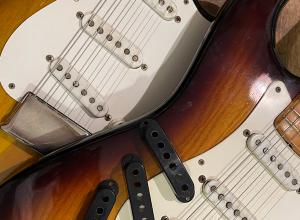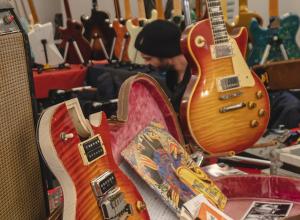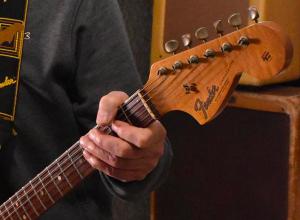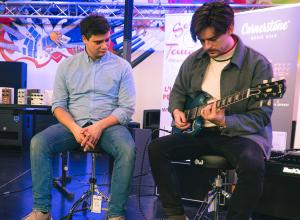Rudy è diventato un buon amico del nostro Francesco Balossino e i due hanno recentemente collaborato per restaurare alcune delle chitarre vintage di Rudy con i nostri liutai del ToneTeam qui in Italia.
Oggi qui a Vintage Vault abbiamo chiesto a Rudy di rispondere ad alcune domande sulla sua storia, sulla sua passione e sulle sue aspettative future.
Domanda: Buongiorno Rudy e grazie per essere qui con noi oggi! Cominciamo con la domanda (solo apparentemente) più facile: cosa significa per te “Vintage”?
Risposta: Vintage significa tanti chilometri, un bel viaggio da luoghi diversi, cose diverse. Quando dico vintage penso al vino, alle auto, alle chitarre, a tutto. Vintage è una parola bellissima perché rappresenta la storia dello strumento o di qualsiasi cosa sia. Non mi definisco un vecchio, dico "sono vintage".
D: Quando hai comprato la tua prima chitarra “vintage”? Qual è stata?
R: La mia prima chitarra vintage l’ho comprata in Argentina, era una Jaguar del 1964, ed era il 1966. L’ho trovata non molto lontano da casa mia, ricordo che è stato il mio primo incontro con una chitarra vintage, e si dà il caso che fosse una Jaguar, motivo per cui amo così tanto le Jaguar. Non avevo abbastanza soldi e i membri della mia band hanno dato tutti una mano. Dissi: “Non posso crederci, una Jaguar del 1964!”. Non lo dimenticherò mai.
D: Quando ha capito che quelle “vecchie chitarre” avevano qualcosa di speciale?
R: Beh, come tutti, guardavo sempre le band, diverse band europee e americane, e naturalmente sapevo che era qualcosa di speciale perché – beh, a quel tempo non era vintage, sto parlando degli anni ’60, la chitarra era degli anni ’60, diventano vintage con il passare degli anni.
E mi rendo conto che c’è qualcosa nel legno che era già vecchio all’epoca, come nella mia Jaguar del 1964, sapevo che il legno aveva già vent’anni. Parlando con falegnami e persone che lavorano con il legno, tutti mi dicevano: “Non usiamo mai legno appena tagliato”. Tutti avevano legno vecchio. Questo è uno dei motivi per cui gli strumenti vintage suonano così bene. Oggi la domanda è così alta che di solito gli alberi vengono tagliati subito. Ora si cerca di accelerare il processo con forni e cose del genere.
Ricordo che con un mio amico andavo in un posto dove c’era molto legno, e ricordo grandi pezzi di palissandro brasiliano, lunghi circa trenta, quaranta, cinquanta piedi, spessi cinque o sei pollici, larghi forse un metro e mezzo, e ho fatto dei bellissimi gradini per la mia casa, che sono ancora lì, ventiquattro gradini di vecchio palissandro brasiliano. Non posso credere di essere ancora vivo, perché avrei potuto morire se avessi avuto problemi con i fumi e la polvere.
Ma comunque, ricordo che dicevo al tizio: “Lasci il legno fuori?”. E lui rispondeva: “Oh, sì, è il processo migliore, bagnarsi, prendere il sole e passare attraverso le stagioni, fa davvero bene al legno”. A quel tempo la gente ne aveva una tonnellata perché non se ne faceva molto uso. Oggi se ne fa tantissimo. Ma questo è uno dei motivi per cui i vecchi strumenti suonano così bene.
D: Qual è il tuo approccio al restauro? Ricordo di aver visto un bellissimo manico D’Angelico di riserva sul banco quando sono venuto a trovarvi l’estate scorsa, che ora farà parte di un progetto incredibile! Dicci di più!
R: Beh, è stato divertente perché Chris Mirabella, che conosco da oltre quarant’anni, è un grande costruttore di chitarre e un grande riparatore. Circa trentacinque anni fa, sulla 48esima strada, è arrivato questo tizio con il manico della chitarra in mano e con l’altra mano l’attaccacorde.
E mi dice: “Voglio venderla, e ho sentito che le chitarre si vendono a buon prezzo”.
Beh, a quel tempo le chitarre non venivano vendute per molti soldi, forse tre o quattromila. Gli ho detto: “Quanto vuoi?”.
Voleva mille dollari e glieli ho dati perché, mi sono detto, “dove lo trovo un altro manico Excel con l’attaccacorde? Forse l’ho pagato un po’ troppo, ma l’ho comprato pensando che forse un giorno sarebbe arrivato con il corpo, capisci? Ma non è mai successo. Quel manico è passato dalla 48a a SoHo ed è arrivato qui a Scarsdale. Chris Mirabella è venuto a trovarmi qualche mese fa e mi ha detto, “Wow! Hai un manico D’Angelico?”.
E io ho risposto di sì.
E lui ha detto: “Sai cos’ho? Ho il legno di D’Angelico”.
E io: “Mi prendi in giro?”.
No, Rudy, l’ho comprato dalla moglie di D’Aquisto!”.
Quando John (D’Angelico) morì, Jimmy portò un sacco di legna a casa sua a Long Island. Quando Jimmy morì, il legno andò in California con Gudelsky. Poi, in qualche modo, la moglie di Jimmy conservò ancora un po’ di legna e Mirabella ne prese un po’.
Mi disse: “Vuoi che ti faccia un corpo?”.
E io dissi: “Chris mi stai prendendo in giro?” Avevo aspettato tutto questo tempo aspettando che qualcuno lo facesse!
Lui disse: “Mi piacerebbe farlo. La farò identica a quella di John e farò in modo che il corpo si adatti perfettamente al manico”. Che bel progetto!
Dissi: “Finalmente il manico ha trovato il corpo”. Beh, il corpo non è mai stato realizzato, ma lo sarà. È un progetto bellissimo, non vedo l’ora. Sarà una bellissima Excel di fine anni ’30 o inizio anni ’40”.
D: Quando avete progettato le vostre incredibili Pensa Guitars avevate in mente alcune chitarre iconiche vintage che vi hanno ispirato? È vero che lei e Mark Knopfler stavate cercando di combinare alcune caratteristiche dell’iconica Les Paul del ’59 e alcune della Fender Strat?
R: La chitarra Pensa più famosa, la MK1, ad essere sincero devo dire che l’ha fatta John Suhr, ma il progetto era di Mark. Un giorno Mark stava registrando a Monserrat, forse prima di Brothers in Arms, era molto presto.
Era il periodo natalizio e dissi a John: “Mandiamo una chitarra a Mark”.
All’epoca non si chiamavano Pensa Custom, ma “R Custom”: R come ‘nostra’ e R come Rudy. Non so, il nome era piuttosto divertente. A Mark piaceva la chitarra. Era un corpo piccolo, con il manico in acero, e rossa perché a Mark piaceva Hank Marvin degli Shadows.
Un giorno Mark, con me in una caffetteria a mezzo isolato dalla 48ª tra la 6ª e la 7ª, mi disse: “Amico, vorrei che mi costruissi una chitarra”.
Gli chiesi: “Che tipo di chitarra vuoi?”.
Lui rispose: “Ho un’idea. Sai che mi piacciono le chitarre Fender. Possiamo avere una Fender, con il top intagliato, con gli stessi legni di una Gibson?”.
Ho detto: “Non ci avevo mai pensato, sembra una buona idea!”. E abbiamo scritto l’idea su un tovagliolo. Quella chitarra fu praticamente realizzata a mano, dovetti tagliare il corpo e intagliare il top. Fu la prima Stratocaster con il top intagliato, in seguito Fender e Ibanez la copiarono. Spedimmo la chitarra a Mark, in occasione del Live Aid, e lui arrivò al sound check, gli piacque così tanto che la usò, e questa è la storia della Pensa MK1.
Tra l’altro, anni dopo, qualcuno voleva investire nell’azienda Pensa, e io gli diedi un libro con tutte le foto che avevo, compreso il tovagliolo, e questo tizio mi chiamò poche ore dopo dicendomi che aveva lasciato il libro in un taxi, e tutta la mia storia era scomparsa. E giuro su Dio che ancora non ci credo, alla fine non era un bravo ragazzo. Credo che mi abbia derubato. Da come l’ha detto, non ha chiesto scusa o altro. Comunque, che ci posso fare, è stata colpa mia, non avrei mai dovuto dargliela”. C’era tutta la storia della chitarra Pensa”.
Rudy racconta poi la storia del nome del suo marchio omonimo.
“Abbiamo fatto una chitarra per Lou Reed, è sulla copertina dell’album Mistrial, e Lou era con le chitarre Schecter, e sul fondo dell’album c’era scritto ‘Guitar courtesy of Schecter Guitar’. E io dissi: “John, guarda che stronzata, la chitarra l’abbiamo fatta noi!”.
Non pensavo che saremmo andati da nessuna parte con il nome Schecter.
E John disse: “Perché non lo chiami Pensa, questo è il tuo negozio”.
Me lo ricordo come se fosse oggi. Io dissi: “Sì, è il mio negozio, ma tu le produrrai. Chiamiamolo Pensa-Suhr”.
Non avevamo nemmeno una decalcomania, avevamo una pressa per incidere il nome sulla paletta. Abbiamo fatto, non so, forse 10-15 chitarre così e poi abbiamo fatto fare una decalcomania.
D: Secondo George Gruhn, “Vintage” si riferisce alla “Golden Era” della produzione di ciascun marchio. A questo proposito, quale pensa possa essere considerato l’apice di Pensa Guitars fino a oggi?
R: Ho avuto con me forse dieci o dodici costruttori di chitarre, tutti ancora in attività. Abbiamo iniziato con John Suhr, Mas Hino, Jimmy Cappolo, Steven Marchione, Jay Black, Vinny Socaccio, Izzy Lugo, Larry Fitzgerald a Long Island. Dieci o dodici persone. Sono tutti in attività, è fantastico e siamo tutti amici. Poi, circa vent’anni fa, è arrivato Makoto e credo che ora sia l’epoca d’oro. Penso che Makoto e Joe stiano realizzando le migliori Pensa di sempre. Onestamente, tra tutti quelli che ho avuto, Mak è il migliore. Non che John Suhr non fosse bravo, John era fantastico. Anche tutti gli altri ragazzi, devo dire che tutti erano bravi. Ma Makoto è assolutamente incredibile. Lui e Joe. Joe è qui da dieci anni e Makoto da venti. Penso che sia l’epoca d’oro in questo momento.
D: Una chitarra che hai venduto e che poi ti sei pentito di aver venduto?
R: Tutte. Non vorrei mai vendere nessuna chitarra. Le amo tutte: sono come i miei figli. C’è un piccolo rimpianto per ognuna di esse. Ma cosa vuoi fare? In realtà non possediamo nulla e dobbiamo condividerlo. Non si può portare con sé. Ed è bello passare la torcia ad altre persone. Pensate a un violino Stradivari o a un Amati, che hanno quasi quattro o cinquecento anni, a quanti proprietari diversi li hanno avuti. E sai, la mia unica preoccupazione è sempre stata: “Cosa diavolo succederà quando morirò?”. E un giorno mi sveglio e mi dico: “Non succederà nulla! Tu non ci sarai più e la chitarra resterà per altri trecento anni.
D: La scoperta di chitarra più folle e inaspettata che hai fatto?
R: Una di queste è stata qualche anno fa. Ho trovato questa incredibile, incredibile D’Angelico New Yorker Special del 1934 che nessuno sapeva fosse mai stata prodotta. Una New Yorker da 17 pollici; non ho mai visto una New Yorker da 17 pollici. La paletta era una New Yorker, il corpo era una Excel. Era un pezzo unico, l’abbiamo trovata solo in un libro. Sono stato molto felice di trovare quella chitarra. Devo dire che il suono era incredibile. Molte persone volevano comprare la chitarra da me quando hanno scoperto che ce l’avevo, perché alcuni sapevano che l’avevano fatta, altri no. Quando ho detto ad alcune persone che l’avevo trovata, ho ricevuto tantissime telefonate.
Era il periodo natalizio e andai nel New Jersey da una famiglia che lo aveva da moltissimi anni. Era il periodo della pandemia e non ho mai visto in vita mia una casa così decorata, dall’esterno all’interno, tutto. Guardavo ovunque, ma dovevo concentrarmi sulla chitarra. Mia moglie era un po’ scontenta che me ne andassi a Natale, ma io le dissi: “No, devo andare a prenderla nel caso cambiassero idea”.
Il proprietario originale era un amico di Tony Mottola. E mi disse: “Mottola mi ha detto di prendere una chitarra da 17 pollici”. Ha le stesse buche a F della chitarra di Tony Mottola. Il manico è quasi troppo grande per il corpo, perché doveva essere una New Yorker da diciotto pollici, e il ragazzo ha detto: “No, Tony mi ha detto di prenderne diciassette”, e D’Angelico, per protesta, credo, l’ha fatta, ma ha fatto una New Yorker con un corpo Excel. Non so dirvi quanto fui felice di trovare quella chitarra.
D: Il marchio/modello Vintage più sottovalutato
R: La Jazzmaster, la Jaguar, erano le chitarre più costose della Fender e ora la Strat è dieci volte più costosa a causa delle persone che l’hanno suonata. Sono chitarre sottovalutate. Una volta andavo alle mostre di chitarre e compravo Les Paul Junior per tre, quattro, cinquecento dollari tutto il giorno, mentre ora costano una cifra incredibile. Anche queste sono sottovalutate. Anche alcune delle vere D’Angelico dovrebbero valere molto di più.
Ogni marca ha qualcosa, ma a volte la gente valuta gli strumenti non tanto per quello che sono, ma per chi li ha suonati. Per me è un po’ triste, ma è così che vanno le cose.
D: Qual è la chitarra più rara che hai trovato nella tua carriera?
R: La D’Angelico New Yorker Special. John, e anche Jimmy (D’Aquisto), molte volte, non scriveva le cose perché le vendeva per soldi o altro, a volte vedi una chitarra e non è sul registro originale. Sai, facevano chitarre e non pensavano che un giorno sarebbero diventate “chitarre d’epoca”. Abbiamo fatto la stessa cosa con le chitarre Pensa, mi creda.
D: Qual è la tua chitarra “isola deserta” e perché?
R: Oh, sapevo che sarebbe arrivata. Non so dire la marca in questo momento, ma sarebbe una corda di nylon. Una chitarra classica di nylon. È quella che studiavo da bambino ed è quella che amo. Le amo tutte, ma sicuramente sarebbe quella. So che se non fosse così mi mancherebbe da morire. È un attaccamento speciale.
D: Qual è la tua percezione sul futuro di “Vintage Guitars”?
R: Vengo da una generazione in cui, crescendo, le chitarre cominciavano a diventare vintage. Ma oggi le cose sono cambiate. Quando un ragazzo di quindici o diciassette anni viene nel mio negozio e mi chiede: “Avete chitarre vintage?” e io comincio a dirgli: “Oh, ho chitarre del 1960 e…” “Oh no, no, sto cercando il 2005”.
Io dico: “Aspetti un attimo”.
Quando ho aperto nel 1978, il ’58 era solo 20 anni fa. Per questo ragazzo, il 2005 è molto tempo fa. Per lui è vintage.
Le chitarre vintage saranno come i violini di Stradivari. Tutti sapranno dove sono, ma solo pochi musicisti le possederanno. Al momento sono di proprietà di aziende, società di investimento, miliardari. Oggi, i bambini che stanno nascendo, stanno tutti scoprendo Jimi Hendrix, i Led Zeppelin. Non finirà mai. Quando avrà cento, duecento anni, sarà come per i violini: quelli molto vecchi saranno intoccabili per la gente comune. La gente potrà suonarli? Sì, se l’azienda permetterà loro di usarli come fanno ora con i violini Stradivari.
Ringraziamo Rudy per il tempo che ci ha dedicato oggi e vi invitiamo a seguirlo su , e sul suo .
[EN] Vintage Visions from the world: Rudy Pensa from Rudy’s Music - United States
Rudy’s Music is a must-see historical shop in NYC, and Rudy Pensa, its owner and founder, is one of the most passionate guys in the business. Since the late 70s Rudy has met some of the finest guitar builders and players, and has also designed beautiful guitars under his own name, the “Pensa Custom Guitars”, that have contributed to define what we call “Boutique” instruments nowadays.
Rudy’s become good friends with our own Francesco Balossino, and the two recently partnered to restore some of Rudy’s Vintage Guitars with our ToneTeam Luthiers here in Italy.
Today here at Vintage Vault we’ve asked Rudy to answer to a few questions regarding his story, passion and future expectations. Rudy speaks with a thick Argentinian accent, which has been partially left intact in these transcriptions, but edited for brevity and clarity.
Question: Good morning Rudy and thanks for being here today with us! So let’s start with the (only apparently) easiest question….What does “Vintage” mean for you?
Answer: Vintage means a lot of miles, a beautiful journey from different places, different things. When I say vintage I think about wine, cars, guitars, everything. Vintage is a beautiful word because it represents the history of the instrument or whatever it is. I don’t call myself an old man, I say, "I’m vintage.”
Q: When did you buy your very first “vintage” guitar? Which one was it?
A: My first vintage guitar was bought in Argentina, it was a 1964 Jaguar, and that was in 1966. I find it not too far away from my house, I remember it was my first encounter that I had with a vintage guitar, and it happened to be a Jaguar, which is why I love Jaguars so much. And I don’t have enough money, and the people in my band all chipped in. I say, ‘I can’t believe it, a 1964 Jaguar!’ I never forget.
Q: When did you realize that those “old guitars” had something special?
A: Well, like everybody else, I was always looking at the bands, different bands from Europe and America, and of course I knew it was something special because- well at that time it wasn’t vintage, I’m talking about the 1960’s, the guitar was from the 1960’s, they become vintage through the years.
And I realize, it’s something about the wood that was old already at the time, like in my 1964 Jaguar, I knew the wood was twenty years old already. Talking to carpenters and people who work in wood, everybody used to tell me, ‘We never use wood that was just cut.’ Everybody had old wood. That’s one of the reasons they sound so good, the vintage instruments. Today the demand is so high, they usually cut trees right away. Now they try to accelerate the process with ovens and stuff like that.
I remember, I used to go to a place with a friend of mine that had a lot of wood, and I remember big pieces of Brazilian Rosewood, I’m talking about thirty, forty, fifty feet long, and five or six inches thick, maybe two feet wide, and I made beautiful steps for my house which are still there, twenty-four steps of old Brazilian Rosewood. I can’t believe I’m still alive, because I could have died, you know, if I had a problem with the fumes and the dust.
But anyway, I remember, I used to say to the guy, ‘You leave the wood outside?’ And he said, ‘Oh, yeah, that’s the best process, to get wet, with sun and to go through the seasons, it’s really good for the wood.’ At that time people had a ton because there wasn’t too much use for it. Today it’s so much. But that’s one of the reason it sounds so good, the old instruments.
Q: What is your approach to Restoration? I recall seeing a beautiful spare D’Angelico neck on the bench when I visited you last summer, that now is going to be part of an incredible project! Tell us more!
A: Well it was funny because, Chris Mirabella , I know him for over forty years, he’s a great guitar maker, great repairman. Maybe thirty five years ago, on 48th Street, this guy come from the street with a (guitar) neck in his hand, and his other hand he has the tailpiece.
And he says, ‘I want to sell this, and I heard the guitars go for good money.’
Well, at that time the guitars weren’t going for a lot of money, maybe three or four thousand. I say, ‘How much you want?’
And he wanted a thousand dollars, and I gave it to him because, I said, ‘Where am I going to find another Excel neck by itself with the tailpiece? Maybe I pay him a little too much, but I bought it thinking, maybe someday will walk in with the body, you know? But it never happened. That neck went from 48th to SoHo, and it came here to Scarsdale. Chris Mirabella visited me a few months ago and said,
‘Wow! You have a D’Angelico neck?’
And I said yes.
And he said, ’You know what I have? I have D’Angelico’s wood.’
I said, ‘Are you kidding me?’
‘No, Rudy, I bought it from D’Aquisto’s wife!’
When John (D’Angelico) died, Jimmy took a lot of wood to his place in Long Island. When Jimmy died, the wood went to California with Gudelsky. And then somehow, Jimmy’s wife still kept some wood, and he Mirabella got some.
He said, ‘You want me to make you a body?’
And I said, ‘Chris are you kidding me?’ I’d waited all this time waiting for somebody to!
He said, ‘I’d love to do it. I’ll do it identical to John, and I’ll make the body match perfectly to the neck. What a beautiful project. I said, ‘Finally the neck found the body.’ Well, the body was never made, but it’s going to be. It’s a beautiful project, I can’t wait. It’s gonna be a beautiful late 30’s or early 40’s Excel.”
Q: When you designed your incredible Pensa Guitars, did you have some Iconic Vintage guitars in mind which inspired you? Is it true that you and Mark Knopfler were trying to combine some features of the Iconic ’59 Les Paul and some of the Fender Strat?
A: The most famous Pensa guitar, the MK1, to be honest with you, I have to say that John Suhr made it, but the design was Mark. One day Mark was recording in Monserrat, maybe before Brothers in Arms, it was very early.
It was Christmas time and I said to John, ‘Let’s send a guitar to Mark.’
And they weren’t called Pensa Custom at the time, we called them ‘R Custom’: R for ‘ours’, and R for Rudy. I don’t know, the name was kind of funny. And Mark liked the guitar. It was a little dinky body, maple neck, and red because Mark likes Hank Marvin from the Shadows.
One day, Mark, with me in a coffee shop, half a block from 48th between 6th and 7th, said ‘Man, I’d like to you build me a guitar.’
I said, ‘What kind of guitar do you want?’
He said, ’I have an idea. You know I like Fender guitars. Can we have a Fender, carved top, with the same woods like a Gibson?”
I said, ’I’ve never thought about it, it sounds good!’ And we wrote the idea on a napkin. That guitar was basically made by hand, he had to cut the body, carve the top. It was the first Stratocaster with a carved top, later on Fender and Ibanez copied it. We shipped the guitar to Mark, at Live Aid, and he got to the sound check, loved it so much he used it, and that’s the story of the Pensa MK1.
By the way, years later, someone wanted to invest in the Pensa company, and I gave him a book with all the pictures I had, including the napkin, and this guy called me a few hours later and told me he left the book in a taxi, and my whole history disappeared. And I swear to God, I still don’t believe this guy, he ended up not being a good guy. I think he stole from me. The way he said it, he didn’t say sorry or anything. Anyway, what can I do, it was my fault, I should have never given it to him. The whole history of Pensa guitar was there.”
Rudy goes on to tell the story of the name of his eponymous brand.
“We made a guitar for Lou Reed, it’s on the cover of the album Mistrial, and Lou was with Schecter guitars, and on the bottom of the album it said ‘Guitar courtesy of Schecter Guitar.’ And I said, ‘John, look at this bullshit, we made the guitar!’
I didn’t see us going anywhere with the Schecter name.
And John said, ‘Why don’t you call it Pensa, this is your shop.’
I remember It like it was today. I said, ‘Yeah it’s my shop, but you’re going to make them. Lets call its Pensa-Suhr.’
We didn’t even have a decal, we had a press type, to press the name into the headstock. We made, I don’t know, maybe 10-15 guitars like that and then we had a decal made.
Q: According to George Gruhn, “Vintage” refers to each own brand production “Golden Era”. In this respect, what do you think could be considered Pensa Guitars Peak so far?
A: I’ve had maybe ten or twelve guitar builders that are all in business. We started with John Suhr, Mas Hino, Jimmy Cappolo, Steven Marchione, Jay Black, Vinny Socaccio, Izzy lugo, Larry Fitzgerald in Long Island. Ten or Twelve guys. They’re all in business, it’s fantastic, and we’re all friends. And then about twenty something years ago, Makoto came, and I think it’s the golden era right now. I think Makoto and Joe are making the best Pensas ever. Honestly, out of everyone I’ve had, Mak is the best. Not that John Suhr wasn’t good, John was great. All the other guys too; I’ve got to say everyone was good. But Makoto is absolutely incredible. Him and Joe. Joe’s been here ten years, and Makoto twenty something. I think it’s the golden era right now.
Q: A guitar you sold and then regretted selling?
A: Every one of them. I never want to sell any guitar. I love them all: they’re like my kids. There’s a little regret with every one. But what are you going to do? We don’t own anything really and we have to share it. You can’t take it with you. And it’s nice to pass the torch to other people. Think about a Stradivarius violin or an Amati where they’re nearly four or five hundred years old, how many different owners had them. And you know, my only worry was always, ‘What the hell when I die was going to happen?’ And one day I wake up, and I say, ’Nothing is going to happen! You’re going to be gone and the guitar is going to stay another three hundred years.'
Q: The craziest/unexpected guitar find you ever had?
A: One of them was some years ago.
I found this amazing, amazing 1934 D’Angelico New Yorker Special that no one knew was ever made. A seventeen inch New Yorker; I’ve never seen a New Yorker that was seventeen inches. The headstock was a New Yorker, the body was an Excel. It was one of a kind, we only found it in one book. I was very happy to find that guitar. I got to tell you, the sound was amazing. A lot of people wanted to buy the guitar from me when they found out I had it because some people knew they made it, some people they didn’t. When I told a few people that I found it, I got so many phone calls.
It was Christmas time, and I went to New Jersey to a family that had it for many, many years. It was over the Pandemic, and I’ve never seen a house in my life so decorated from the outside to the inside, everything. I was looking everywhere, but I had to concentrate on the guitar. My wife was a little unhappy that I was leaving on Christmas, and I said, ‘No, I have to go get it in case they change their mind.’
The original owner was a friend of Tony Mottola. And he said, ‘Mottola told me to get a seventeen inch guitar.’ It has the same F holes as Tony Mottola’s guitar. The neck is almost too big for the body, because it was going to be a New Yorker, eighteen inches, and the guy said, ‘No, Tony told me to get seventeen,’ and D’Angelico, under protest, I guess, made it, but made a New Yorker with an Excel body. I can’t tell you how happy I was to find that guitar.
Q: The most underrated Vintage brand/model
A: The Jazzmaster, the Jaguar, they were the most expensive guitars by Fender and now the Strat is ten times more expensive because of the people who played it. You know, those are underrated guitars. I used to go to the guitar shows and buy Les Paul Juniors for three, four, five hundred dollars all day long and now they go for an incredible amount of money. Those are underrated as well.
Also some of the real D’Angelicos should be much more.
Every brand has something but sometimes people value the instruments not so much for what they are, but for who played them. To me, it’s a little sad, but that’s the way it is.
Q: Which is the rarest guitar you’ve found in your career?
A: The D’Angelico New Yorker Special. John, and Jimmy (D’Aquisto) too, many times, wouldn’t write thing downs because he’d sell it for cash or something, sometimes you see a guitar and it’s not on the original ledger. You know, they were making guitars and didn’t think they would be ‘vintage guitars’ one day. We did the same thing with Pensa guitars, believe me.
Q: Which is your “desert island” guitar, and why?
A: Oh, I knew this was coming. I can’t say the brand right now, but it would be a nylon string. A classical nylon guitar. That’s what I was studying when I was a kid, and that’s what I love. I love them all, but it definitely would be that. I know if it wasn’t that I would miss it like crazy. It’s a special attachment.
Q: What is your perception about the future of “Vintage Guitars”?
A: I came from the generation that as I grew up, the guitars were starting to become vintage. But that changed today. When a kid comes to my shop who’s fifteen years old, seventeen, and I asks, ‘Do you have vintage guitars,’ and I start to say to him, ‘Oh I have 1960’s and- ‘Oh no, no, I’m looking for 2005.’
I say, ‘Wait a minute.’
When I opened in 1978, ’58 was only 20 years back. For this kid, 2005 is a long time ago. For him that is vintage.
Vintage guitars are going to be like the Stradivarius violins. Everyone will know where they are, only a few musicians will own them. Right now they’re owned by corporations, investment companies, billionaires. Today, the kids being born, they’re all discovering Jimi Hendrix, Led Zeppelin. It’s never going to end. When it’s a hundred, two hundred years old, it’ll be like the violins: the very old ones will be untouchable by regular people. Will people be able to play them? Yes, if the corporation lets them use it like they do with the Stradivarius violins now. |
 VINTAGE VAULT
VINTAGE VAULT
 SHG MUSIC SHOW
SHG MUSIC SHOW
 PEOPLE
PEOPLE
 STORE
STORE
 - Privacy - Accordo.it Srl - P.IVA 04265970964
- Privacy - Accordo.it Srl - P.IVA 04265970964
![Vintage Visions from the world: Rudy Pensa di Rudy’s Music - Stati Uniti [IT-EN] Vintage Visions from the world: Rudy Pensa di Rudy’s Music - Stati Uniti [IT-EN]](https://www.accordo.it/cloud-assets/730x450/redazionea5/images/deco/105434_rudy-g.jpg)

































